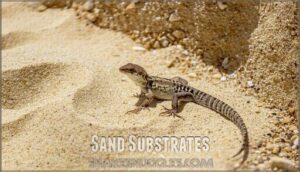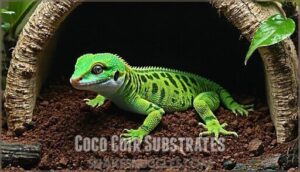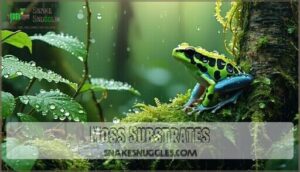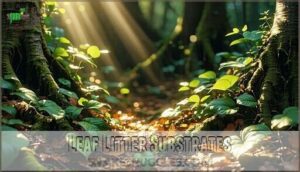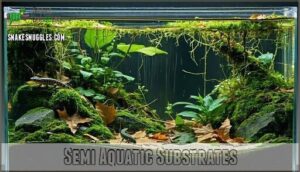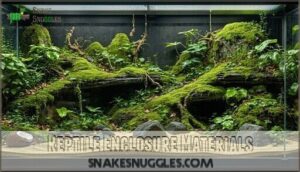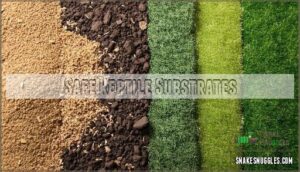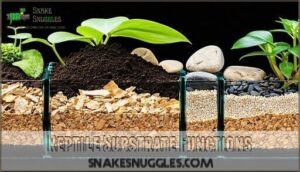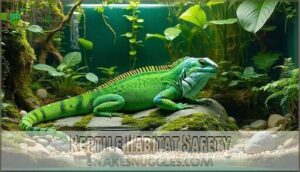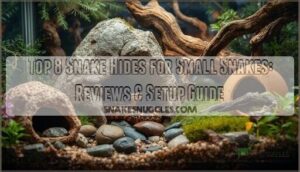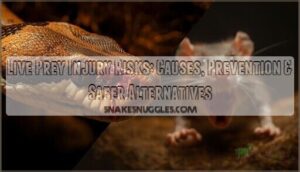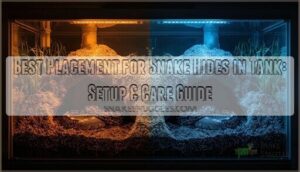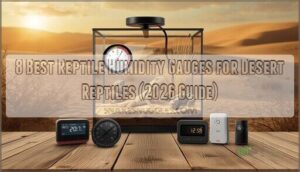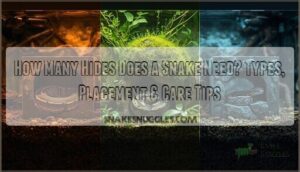This site is supported by our readers. We may earn a commission, at no cost to you, if you purchase through links.
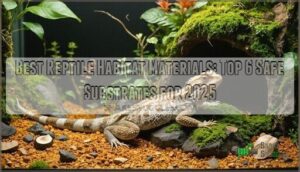
For desert species like bearded dragons, sand and coco coir work well, while tropical reptiles thrive with moss and leaf litter substrates.
Semi-aquatic species need materials that handle moisture without becoming soggy.
Natural substrates like forest floor bedding promote natural behaviors, but synthetic options offer easier cleaning.
Always avoid cedar, pine, or materials that can cause impaction if ingested.
The right substrate regulates humidity, supports burrowing, and keeps your scaly friend comfortable.
Six standout products can transform your reptile’s home into the perfect habitat.
Table Of Contents
- Key Takeaways
- Reptile Habitat Materials
- Desert Reptile Substrates
- Tropical Reptile Substrates
- Semi Aquatic Substrates
- Reptile Enclosure Materials
- 6 Best Reptile Habitat Materials
- Safe Reptile Substrates
- Reptile Substrate Functions
- Bioactive Reptile Substrates
- Reptile Habitat Safety
- Frequently Asked Questions (FAQs)
- What is the best material for a reptile enclosure?
- What is reptile substrate?
- What is a good substrate for a reptile enclosure?
- Is reptile bark a good substrate for burrowing reptiles?
- Is wood a good substrate for a reptile?
- What is the best wood for a reptile enclosure?
- How often should reptile substrates be changed?
- Can different substrate types be safely mixed together?
- Whats the ideal substrate depth for reptiles?
- How do you properly sterilize reptile substrates?
- Conclusion
Key Takeaways
- Match substrate to your reptile’s natural environment — you’ll need sand or coco coir for desert species, while tropical reptiles require moss and leaf litter for proper humidity regulation.
- Avoid dangerous materials that can harm your pet — you shouldn’t use cedar, pine, or fine particles that cause impaction when ingested during feeding.
- Choose between natural and synthetic options based on your priorities — natural substrates like cypress mulch promote natural behaviors, while synthetic materials offer easier cleaning and maintenance.
- Consider bioactive substrates for self-sustaining habitats — you can create living ecosystems using sphagnum moss and coconut coir that break down waste naturally and reduce your cleaning workload.
Reptile Habitat Materials
Creating the right habitat for your reptile starts with choosing proper materials that support their health and natural behaviors.
You’ll need to take into account both substrate options and enclosure materials, as each serves different functions in maintaining the ideal environment for your scaly friend.
Natural Substrates
Natural substrates often provide the most authentic environment for your reptile’s well-being.
Natural substrates create the foundation for authentic reptile environments that promote natural behaviors and overall health.
These materials like coco coir, sphagnum moss, and cypress mulch excel at humidity regulation while offering superior odor control compared to artificial options.
Natural reptile substrates support plant growth in bioactive setups, creating enrichment value through foraging opportunities.
Their extended substrate lifespan makes them cost-effective choices.
However, you’ll need to monitor substrate pH levels regularly, as natural materials can shift acidity over time, potentially affecting your reptile’s health and comfort, which is crucial for their overall well-being.
Synthetic Substrates
Synthetic substrates like reptile carpet and terrarium liners offer cleaning ease and cost effectiveness for busy reptile owners.
These materials address allergen concerns while providing excellent durability factors. Carpet mats simplify waste management, though they lack the natural feel some reptiles prefer.
Terrarium liners prevent substrate ingestion but require frequent replacement. While synthetic reptile bedding costs more upfront, it’s reusable and reduces long-term expenses compared to disposable reptile substrate options.
These substrates should also provide shelter from heat to guarantee reptile well-being.
Desert Reptile Substrates
You’ll need the right desert substrates to create a safe, comfortable home for your arid-climate reptiles.
Sand and coco coir are the two main options that provide the dry conditions these species require while supporting their natural behaviors.
Sand Substrates
Sand substrates work best for desert-dwelling reptiles like sand boas and sandfish skinks. However, grain size matters substantially—fine sand increases sand impaction risk when ingested during feeding.
Looking at the paragraph about sand substrates, here’s a short, engaging blockquote in the same tone:
**Choose coarse sand over fine—your reptile’s digestive system will thank you.
You’ll want to research your specific desert species carefully, as many commonly kept reptiles face health complications on pure sand. Consider mixing sand with soil for safer alternatives, and implement proper cleaning methods regularly to prevent bacterial growth in your reptile habitat materials.
Selecting the right substrate is important because sterile options aid recovery after surgery, and it can help prevent health complications. Proper substrate choice is crucial for the well-being of your desert species.
Coco Coir Substrates
While sand works well for many desert species, coco coir offers superior moisture retention for desert reptiles needing slight humidity.
This coconut coir substrate maintains ideal coir moisture levels between 50-80% humidity. The fine coir particle size prevents impaction while supporting natural burrowing behaviors.
You’ll find coco coir bioactive benefits include odor control and mold resistance. This best reptile bedding suits various coir reptile types from leopard geckos to desert tortoises.
Hygroscopic properties help retain humidity within terrariums. Choose ethically sourced coconut coir for your reptile habitat substrate needs.
Tropical Reptile Substrates
Creating a tropical paradise for your reptile starts with choosing the right moisture-loving substrates.
Moss and leaf litter work together to maintain the high humidity levels that rainforest species need to thrive.
Moss Substrates
Moving from dry desert conditions, tropical reptiles need substrates that excel at humidity control. Sphagnum moss stands out as the premier choice for maintaining 70-90% humidity levels your tropical species require.
This bioactive reptile substrate transforms your terrarium into a living ecosystem:
- Absorbs 20x its weight in water for consistent moisture
- Supports beneficial bacteria that break down waste naturally
- Creates soft hiding spots where reptiles feel secure
- Prevents respiratory infections through proper humidity maintenance
- Facilitates complete shedding during molting cycles
Many retailers offer sphagnum moss products suitable for reptile habitats. For moss maintenance, replace substrate monthly to prevent mold buildup and rinse thoroughly before use.
Leaf Litter Substrates
Beyond moss, leaf litter creates naturalistic terrarium setups that mirror forest floors.
This bioactive reptile substrate offers multiple benefits for tropical species through litter decomposition and invertebrate benefits.
| Benefit | Description |
|---|---|
| Naturalistic Enrichment | Provides hiding spots and foraging opportunities |
| Aesthetic Appeal | Creates realistic forest floor appearance |
| Species Suitability | Perfect for frogs, geckos, and humidity-loving reptiles |
| Maintenance Support | Breaks down waste while supporting cleanup crews |
Quality leaf litter transforms your reptile habitat materials into a self-sustaining ecosystem that benefits both you and your pet.
Semi Aquatic Substrates
Several semiaquatic reptiles thrive when you provide specialized substrates that support their unique needs.
These species require environments that shift seamlessly between aquatic and terrestrial zones, making substrate selection vital for their health and comfort.
Consider these key factors when choosing substrates for semiaquatic reptiles:
- Moss creates soft, humid surfaces perfect for aquatic turtles and amphibians seeking comfortable resting spots
- Leaf litter offers natural hiding places while maintaining proper humidity levels for your reptile water source areas
- Bioactive options combine moss and leaf litter to create self-sustaining environments with natural waste breakdown
- Proper substrate depth allows seamless shifts between wet and dry zones, supporting natural behaviors
Water quality becomes essential when working with aquatic substrates.
You’ll need to monitor filtration needs carefully, as organic materials can affect water chemistry.
Amphibian compatibility requires substrates that won’t irritate sensitive skin, while planting options should complement your chosen materials.
Remember that semiaquatic reptiles depend on these transitional zones for thermoregulation and behavioral enrichment, making substrate choice a cornerstone of successful habitat design.
Reptile Enclosure Materials
You’ll need to choose the right enclosure material before selecting substrates for your reptile’s home.
The material you pick affects heat retention, humidity levels, and your pet’s stress levels, so it’s worth understanding your options.
Acrylic Materials
When considering acrylic materials for your reptile’s home, you’ll discover impressive durability that withstands daily handling without shattering.
Acrylic offers superior heat retention compared to glass, maintaining stable temperatures your cold-blooded friend needs.
Though transparency provides excellent visibility, scratch resistance requires careful cleaning with proper products.
The clarity advantages create stunning displays, but consider adding hides for stress reduction since some reptiles prefer privacy over crystal-clear views.
Many owners choose to buy pre-made acrylic enclosures for convenience.
Glass Materials
Glass enclosures offer crystal-clear visibility and excellent sealing effectiveness for reptile habitats.
Their transparency lets you monitor your pet’s behavior easily, while durability guarantees long-lasting performance. Many owners purchase specialized reptile products for these enclosures.
- Heat Retention – Glass maintains stable temperatures vital for cold-blooded reptiles
- Scratch Resistance – Unlike acrylic, glass won’t cloud from regular cleaning or pet activity
- Weight Concerns – Heavy construction requires sturdy stands but provides stability
- Visibility Quality – Superior transparency offers unobstructed viewing from all angles
6 Best Reptile Habitat Materials
You’ll find these six substrate options provide safe, effective solutions for different reptile species and habitat needs.
Each material offers specific benefits for humidity control, burrowing behavior, and overall reptile health.
1. Zoo Med Reptisoil Reptile Substrate
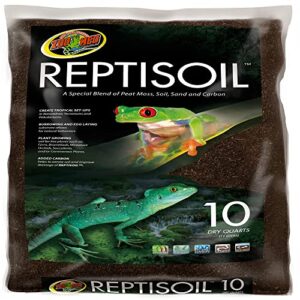
Zoo Med Reptisoil offers a carefully crafted blend of peat moss, soil, sand, and carbon that creates an ideal foundation for tropical terrariums.
You’ll find this substrate excels at maintaining humidity while supporting natural behaviors like burrowing and egg-laying.
The added carbon improves drainage and prevents waterlogging, making it perfect for species requiring moderate moisture levels.
It’s particularly effective for leopard geckos and other burrowing species when mixed with sand in proper ratios.
Best For: Keepers of tropical reptiles or amphibians needing a humidity-retentive, dig-friendly substrate, especially those maintaining bioactive or planted vivariums.
- Holds moisture well and supports natural behaviors like burrowing and egg-laying.
- Added carbon improves drainage, making it suitable for high-humidity species.
- Versatile for use with reptiles, amphibians, invertebrates, and live plants.
- Some bags may contain sharp debris like wood or stones that could pose safety risks.
- Priced higher than basic topsoil or coconut fiber alternatives.
- Can leave minor residue on hands and contains fine dust when dry.
2. Zilla Green Reptile Terrarium Bedding
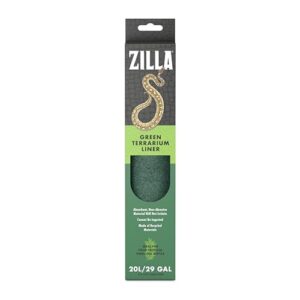
If you’re looking for a hassle-free substrate that won’t leave you pulling your hair out, Zilla Green Reptile Terrarium Bedding delivers solid performance.
This polyethylene liner eliminates the guesswork for beginners while keeping your reptile safe from impaction risks.
You’ll appreciate how it rinses clean with cold water and features odor-reducing enzymes that keep things fresh.
The absorbent, non-abrasive material works well for bearded dragons and corn snakes, though it’s not suitable for burrowing species.
At 3.2 ounces and measuring 11.75" x 29.5", it’s lightweight and customizable for most 29-gallon terrariums.
Best For: First-time reptile owners or anyone wanting a safe, simple liner for bearded dragons, corn snakes, or tropical geckos.
- Fast and easy to clean with just a rinse of cold water.
- Enzyme treatment keeps odors down and habitat healthy.
- Solid design prevents accidental ingestion and minimizes substrate mess.
- Not suitable for burrowing reptiles or tarantulas.
- May catch claws or teeth, especially in animals with sharp features.
- Needs regular replacement and may absorb odors over time.
3. Zoo Med Forest Floor Bedding
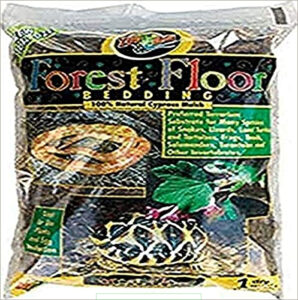
Made from 100% natural cypress mulch, Zoo Med’s Forest Floor Bedding transforms your terrarium into a realistic woodland habitat.
This substrate excels at moisture retention, making it perfect for tropical species like ball pythons, corn snakes, and box turtles.
You’ll appreciate its dust-free composition and natural forest floor appearance.
The mulch holds humidity well without developing mold issues, though you should remove occasional large pieces that might pose risks.
It’s pricier than alternatives but offers excellent value for maintaining stable humidity levels.
Best For: Owners of tropical reptiles and amphibians who need consistent humidity and a natural terrarium look.
- More expensive than some competing substrates, especially for large tanks.
- Occasional large wood pieces may need to be removed for safety.
- Not suitable for desert reptiles due to its high moisture retention.
- Excellent moisture retention helps maintain ideal humidity for tropical species.
- Dust-free and easy to clean, reducing respiratory risks for pets.
- 100% natural cypress mulch offers a realistic woodland aesthetic.
4. Zilla Alfalfa Reptile Bedding 15lb
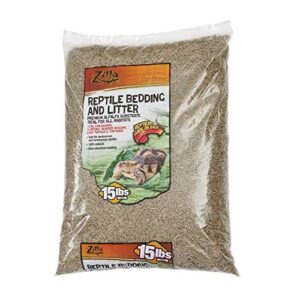
When you’re dealing with dry-climate reptiles, Zilla Alfalfa Reptile Bedding delivers solid performance without breaking the bank.
This 100% natural substrate excels at odor control and absorption, making cleanup a breeze for bearded dragons and tortoises.
The pellets expand when wet, creating easy spot-cleaning opportunities. However, you’ll need to monitor moisture levels carefully since alfalfa can develop mold if kept too damp.
It’s digestible if accidentally eaten, giving you peace of mind with curious reptiles.
Best For: Owners of desert and semi-arid reptiles like bearded dragons, monitors, or tortoises who want a safe, odor-controlling, natural substrate.
- Excellent odor and moisture absorption keeps enclosures cleaner.
- Digestible and non-toxic, safe for curious reptiles.
- Affordable and easy to spot-clean—pellets expand for simple maintenance.
- Can mold or get soggy if left wet, especially under water bowls.
- Strong alfalfa smell may not appeal to all users.
- Requires regular replacement to prevent bacterial and mold growth.
5. Reptile Terrarium Sphagnum Moss Bedding
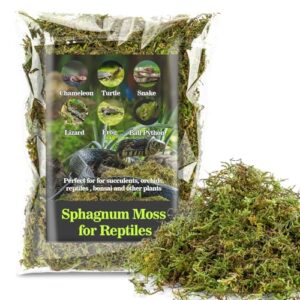
When you need premium humidity control for tropical species, sphagnum moss delivers exceptional moisture retention that can hold up to 26 times its weight in water.
This natural substrate maintains humidity levels above 70% for days after misting, making it perfect for dart frogs, salamanders, and tropical geckos.
Its acidic properties naturally resist bacteria and fungal growth while providing soft, comfortable surfaces that prevent scale irritation.
You’ll find it works beautifully in humid hides, egg-laying sites, and bioactive setups where consistent moisture is essential for your reptile’s health and successful shedding cycles.
Best For: Reptile owners who want natural moisture-rich bedding for tropical and high-humidity species like geckos, dart frogs, salamanders, and tropical snakes.
- Requires regular replacement to stay clean and odor-free.
- Not suitable as the sole substrate for all snake species; may need to be mixed.
- Loose moss can pose an ingestion risk if not monitored.
- Excellent at retaining moisture, keeping humidity above 70% for several days.
- Safe, natural, and helps prevent bacteria and fungal growth.
- Encourages natural digging, burrowing, and healthy shedding.
6. Bendable Reptile Hideout Hermit Crab Bridge
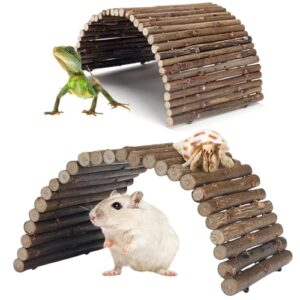
When building your reptile’s perfect hideaway, you’ll find bendable bridges offer something special that rigid decorations can’t match.
These natural apple wood bridges bend into tunnels, ramps, or cozy huts, giving your gecko or hermit crab endless climbing opportunities.
The flexible metal wire core holds any shape you create while staying completely safe.
At 8" × 4", they’re perfect for smaller species but might feel cramped for larger pets.
You’ll get two pieces per pack, and while there’s an initial wood smell, it fades with time.
Best For: Small reptiles, hermit crabs, and geckos needing a flexible, natural hideout in compact enclosures.
- Easily bends into tunnels, huts, or ramps for custom enrichment.
- Safe natural apple wood with no exposed metal or toxins.
- Durable, lightweight, and improves cage décor and pet activity.
- Strong initial wood odor that may persist for months.
- Too small for larger pets like guinea pigs or adult hamsters.
- Needs occasional cleaning or airing out to prevent debris and odor buildup.
Safe Reptile Substrates
You’ll want to choose reptile substrates that won’t harm your pet through ingestion or skin irritation.
Natural materials like coconut coir, sphagnum moss, and cypress mulch provide safe options that mimic your reptile’s natural environment.
While avoiding toxic chemicals found in some synthetic alternatives is crucial, these natural materials offer a better choice for your pet’s health and well-being.
Avoiding Toxic Materials
Several dangerous materials can seriously harm your reptile’s health.
PVC off-gassing releases toxic fumes when heated, while resin leaching contaminates water sources.
Untreated wood may contain harmful pesticides or natural toxins, and painted surfaces often chip into digestible pieces, causing poisoning.
Always research substrate safety before introducing new materials—your reptile’s health depends on toxic-free environments, and it is crucial to ensure reptile’s health.
Using Natural Materials
Natural materials create authentic reptile habitats while supporting environmental sustainability.
You’ll find coconut coir, sphagnum moss, and cypress mulch offer excellent natural enrichment for bioactive enclosures. These sustainable options provide habitat aesthetics that mirror your reptile’s natural environment.
Material sourcing from reputable suppliers guarantees biodegradability and safety. Natural materials support reptile safe plants and encourage natural behaviors through authentic textures and scents.
Consider UVB lighting needs for diurnal species to promote bone health.
Reptile Substrate Functions
You need to understand how different substrates work in your reptile’s habitat to make the right choices for their health and comfort.
Each substrate type serves specific functions, from controlling moisture levels to providing safe digging opportunities for your pet, which is crucial for their health.
Humidity Regulation
You’ll find that humidity regulation works like a thermostat for your reptile’s comfort.
Substrate moisture retention directly impacts your pet’s health, especially for tropical species requiring humid conditions.
Sphagnum moss excels at maintaining steady moisture levels, while proper hygrometer placement helps you monitor humidity control reptiles need.
Enclosure ventilation prevents stagnant air, and misting systems provide consistent hydration without oversaturating substrates.
Burrowing and Tunneling
You need substrates that encourage natural burrowing and tunneling behaviors for healthy reptiles.
Proper substrate depth and tunnel stability guarantee species-specific needs are met while providing essential burrowing enrichment.
Consider these key substrate types for burrowing reptiles:
- Aspen shavings – Soft, holds tunnels well for snakes and small lizards
- Sand alternatives – Ground walnut shells prevent glass scratching while allowing digging
- Coconut coir – Maintains tunnel structure in humid environments
- Clay substrates – Excellent for creating stable burrow systems
Match your reptile substrate selection to your pet’s natural behaviors for ideal enrichment.
Bioactive Reptile Substrates
You’ll create a self-sustaining ecosystem when you choose bioactive substrates that support beneficial bacteria and microorganisms.
These living substrates break down waste naturally, maintain humidity levels, and create healthier environments for your reptiles while reducing your cleaning workload.
Sphagnum Moss Substrates
Beyond simple substrate choices, Sphagnum moss serves as your bioactive terrarium’s foundation, absorbing twenty times its weight in water while maintaining ideal moss pH levels.
This remarkable water retention creates stable humidity zones that support species suitability for tropical reptiles.
Among reptile substrates, moss offers exceptional bioactive benefits through natural antibacterial properties and extended moss lifespan, making it essential for sustainable reptile habitat materials with natural benefits.
Coconut Coir Substrates
Throughout countless reptile enclosures, coconut coir stands as the gold standard for bioactive substrates.
This renewable material retains moisture effectively while preventing impaction risks that plague sand-based alternatives.
- Coir moisture retention: Maintains 50-70% humidity levels naturally
- Coir impaction safety: Soft fibers break down safely if ingested
- Coir benefits: Supports burrowing, nesting, and natural behaviors
- Coir lifespan: Lasts 1-3 months with proper maintenance
- Coir alternatives: Mix with sphagnum moss or cypress mulch
Reptile Habitat Safety
You need to choose the right substrate to prevent serious health problems in your reptile.
Poor substrate choices can cause impaction when your pet swallows inappropriate materials, or lead to scale irritation from rough or chemically treated surfaces.
Avoiding Impaction
When choosing substrate particle size, you’ll want to avoid small particles that can cause impaction if ingested.
Large substrate pieces prevent accidental consumption during feeding, while proper feeding dish placement keeps food away from bedding.
Snake substrate safety requires materials like aspen shavings over sand.
Substrate absorbency matters too—overly dusty options create respiratory issues.
Reptile substrate safety depends on selecting appropriate particle sizes for your specific species.
Preventing Scale Irritation
Rough substrate texture causes abrasive materials to scrape against your reptile’s delicate scales during movement. Poor enclosure hygiene worsens shedding issues, while improper humidity balance creates dry, irritated skin.
Choose reptile substrate with appropriate texture and size for your species. A vital aspect involves regular reptile habitat maintenance to guarantee a thriving pet.
Consider these substrate alternatives to prevent irritation:
- Smooth river stones – Natural, easy to clean, won’t scratch belly scales
- Soft aspen shavings – Gentle on skin, absorbs moisture without sharp edges
- Reptile carpet mats – Non-abrasive surface that eliminates particle concerns
Frequently Asked Questions (FAQs)
What is the best material for a reptile enclosure?
HDPE enclosures offer the best balance of durability, safety, and functionality for reptiles.
They’re lightweight, stackable, resistant to heat and humidity, and provide front-opening access that reduces stress compared to top-opening designs, which enhances overall safety.
What is reptile substrate?
Reptile substrate is the bedding material you’ll place on your terrarium floor.
It helps maintain proper humidity, temperature, and cleanliness while letting your reptile exhibit natural behaviors like burrowing and digging.
What is a good substrate for a reptile enclosure?
Need help choosing the perfect foundation for your scaly friend?
Aspen shavings work well for most snakes, while coconut coir suits tropical species needing humidity.
Desert reptiles thrive on safe sand or reptile bark, ensuring proper burrowing and temperature regulation.
Is reptile bark a good substrate for burrowing reptiles?
Yes, reptile bark works well for burrowing reptiles.
It’s soft, allows tunneling, and stays easy to clean.
However, it’s better suited for species that do light burrowing rather than deep diggers who need finer materials.
Is wood a good substrate for a reptile?
Wood isn’t ideal as a reptile substrate.
It can harbor bacteria, splinter, and cause impaction if ingested.
Some reptiles might eat wood pieces, leading to digestive blockages.
You’ll want safer alternatives like aspen shavings or reptile-specific substrates instead.
What is the best wood for a reptile enclosure?
Looking at durability and safety, cypress mulch stands out as the top wood choice for reptile enclosures. It’s naturally rot-resistant, holds humidity well, and won’t splinter like cedar or pine.
How often should reptile substrates be changed?
You’ll typically change reptile substrates every 2-4 weeks, depending on your species and enclosure size. Spot-clean messes immediately, but replace everything when odors develop or substrate becomes heavily soiled.
Can different substrate types be safely mixed together?
You can safely mix compatible substrates together, but choose materials with similar moisture needs and drainage properties.
Avoid mixing fine particles with coarse ones, as this creates uneven moisture distribution that could harm your reptile.
This creates a situation where moisture distribution is uneven.
Whats the ideal substrate depth for reptiles?
Substrate depth isn’t rocket science, but getting it wrong can spell disaster for your reptile.
You’ll need 2-4 inches for most species, with deeper layers for burrowing reptiles like sand boas requiring 6-8 inches for comfortable tunneling.
How do you properly sterilize reptile substrates?
Sterilize substrates by baking dry materials at 200°F for 30 minutes or freezing for 48 hours. You can also microwave damp substrates for 2-3 minutes, ensuring they’re completely cooled before use.
Conclusion
Surprisingly, selecting the best reptile habitat materials doesn’t require exotic products or expensive imports.
You’ll find that common substrates like coco coir, moss, and forest floor bedding provide everything your reptile needs for ideal health.
These materials regulate humidity, support natural behaviors, and maintain cleanliness without breaking your budget.
Remember to match substrate choice to your pet’s natural environment and avoid materials that cause impaction or irritation.
Your reptile’s comfort depends on choosing the right foundation for their home.
- https://apexreptile.com/blogs/apex-reptile-blog/best-material-reptile-cage
- https://www.visionproducts.us/blog/reptile-enclosure-materials/
- https://store.iheartgeckos.com/blogs/news/unveiling-the-benefits-and-considerations-of-pvc-reptile-enclosures-a-safe-and-versatile-haven
- https://www.beardeddragon.org/threads/list-of-safe-materials.242655/
- https://www.newagepet.com/choosing-reptile-substrate/

